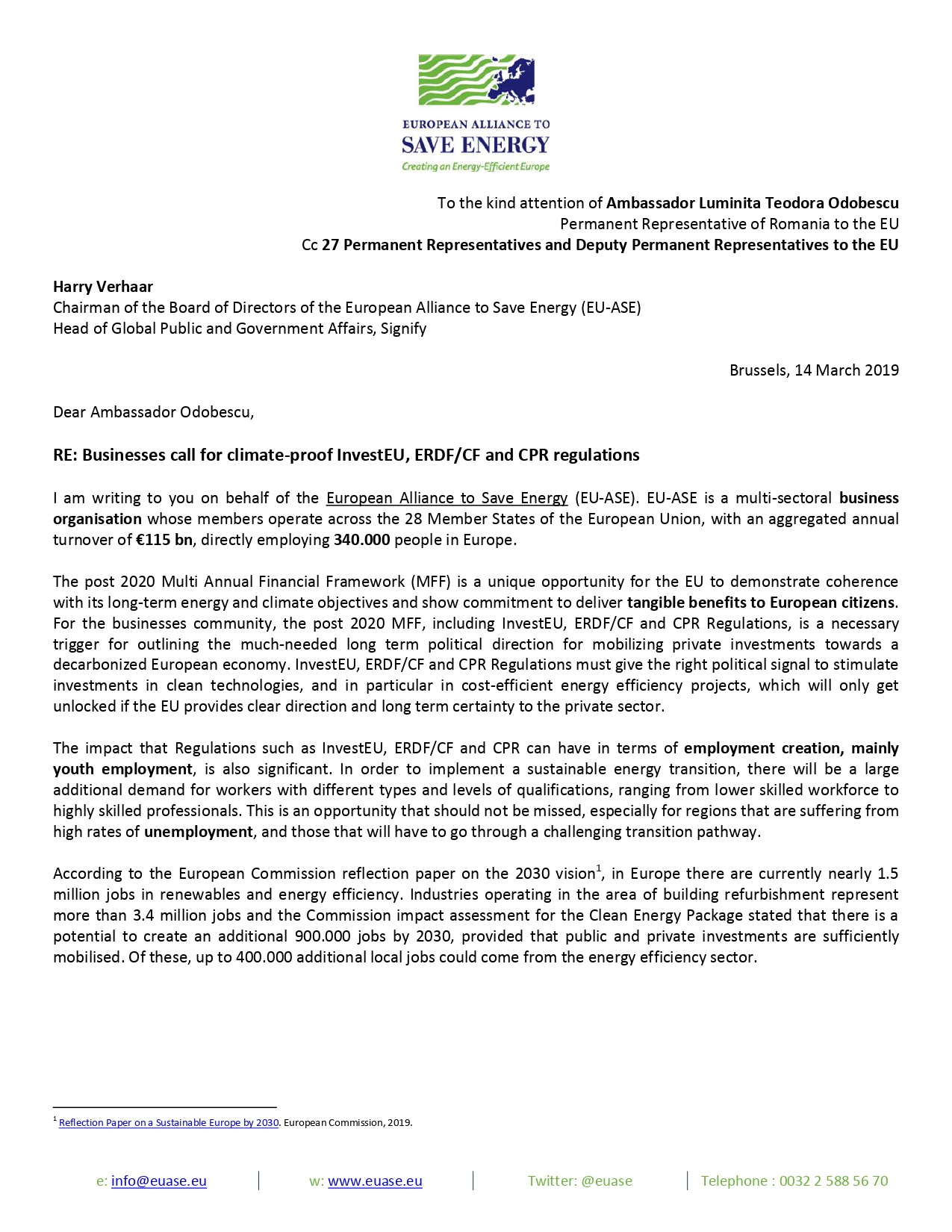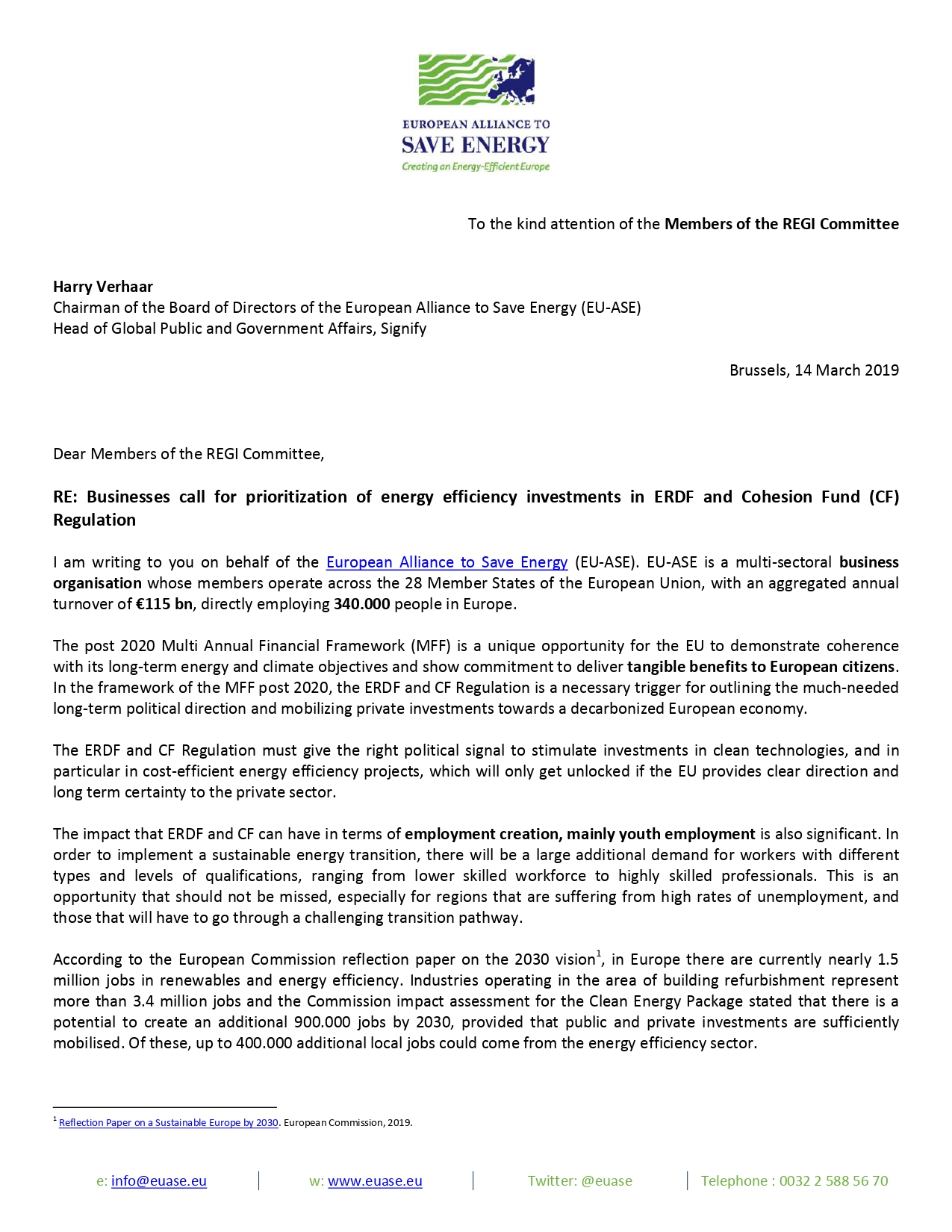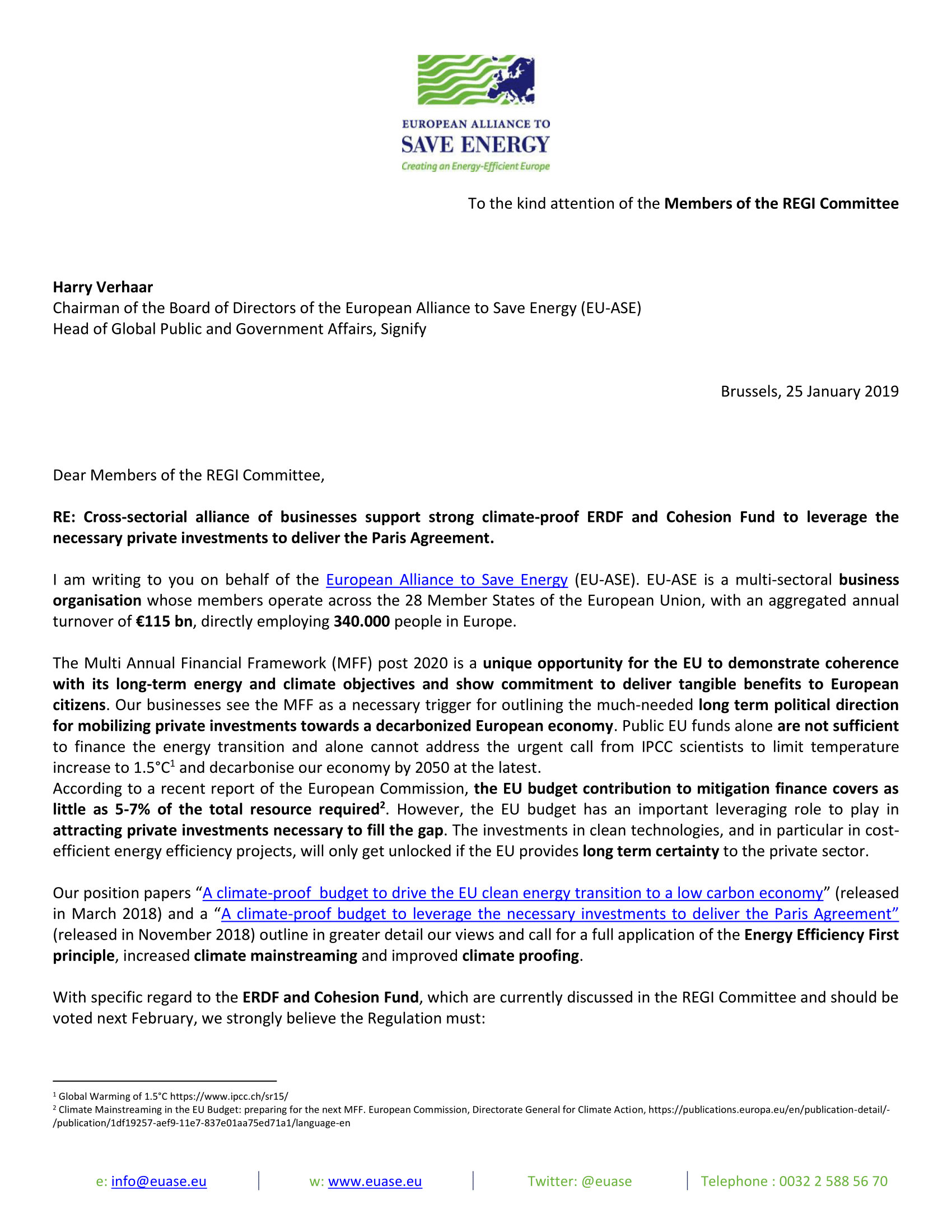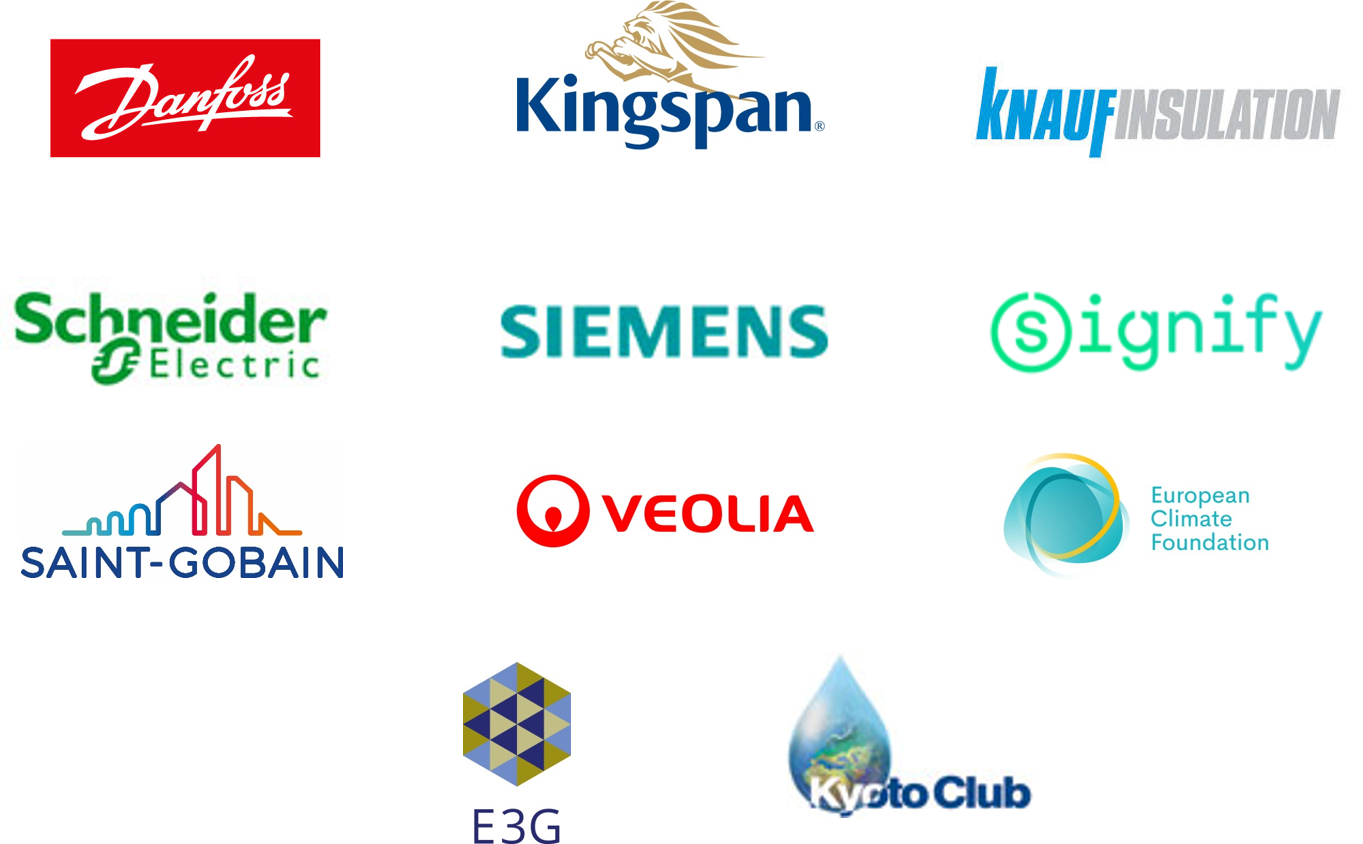Businesses call for climate-proof InvestEU, ERDF/CF and CPR regulations

To the kind attention of Ambassador Luminita Teodora Odobescu
Permanent Representative of Romania to the EU
Cc 27 Permanent Representatives and Deputy Permanent Representatives to the EU
Brussels, 14 March 2019
Dear Ambassador Odobescu,
I am writing to you on behalf of the European Alliance to Save Energy (EU-ASE). EU-ASE is a multi-sectoral business organisation whose members operate across the 28 Member States of the European Union, with an aggregated annual turnover of €115 bn, directly employing 340.000 people in Europe.
The post 2020 Multi Annual Financial Framework (MFF) is a unique opportunity for the EU to demonstrate coherence with its long-term energy and climate objectives and show commitment to deliver tangible benefits to European citizens.
For the businesses community, the post 2020 MFF, including InvestEU, ERDF/CF and CPR Regulations, is a necessary trigger for outlining the much-needed long term political direction for mobilizing private investments towards a decarbonized European economy. InvestEU, ERDF/CF and CPR Regulations must give the right political signal to stimulate investments in clean technologies, and in particular in cost-efficient energy efficiency projects, which will only get unlocked if the EU provides clear direction and long term certainty to the private sector.
The impact that Regulations such as InvestEU, ERDF/CF and CPR can have in terms of employment creation, mainly youth employment, is also significant. In order to implement a sustainable energy transition, there will be a large additional demand for workers with different types and levels of qualifications, ranging from lower skilled workforce to highly skilled professionals. This is an opportunity that should not be missed, especially for regions that are suffering from high rates of unemployment, and those that will have to go through a challenging transition pathway.
According to the European Commission reflection paper on the 2030 vision[1], in Europe there are currently nearly 1.5 million jobs in renewables and energy efficiency. Industries operating in the area of building refurbishment represent more than 3.4 million jobs and the Commission impact assessment for the Clean Energy Package stated that there is a potential to create an additional 900.000 jobs by 2030, provided that public and private investments are sufficiently mobilised. Of these, up to 400.000 additional local jobs could come from the energy efficiency sector.
In view of the current and future trilogues negotiations on InvestEU, ERDF/CF and CPR we urge you to:
InvestEU
- Support the climate mainstreaming target of at least 40% and the earmarking of 65% in the sustainable infrastructure window for Paris-aligned investments as proposed by the European Parliament
The scale of the challenge posed by climate change and its devastating impact on the economy, society and the environment requires substantial public resources to mobilize the necessary private investments.
- End new fossil fuel investments and align investments with climate objectives
We welcome the sustainability proofing mechanism introduced by the European Parliament and the strong language on the need to orient investments to reach climate goals. We do not support fossil fuel exceptions (ref. Annex V) that would allow technological lock-in and short-sighted investments in new gas and coal infrastructures.
InvestEU should instead mobilise investments in energy efficiency improvements to unleash the multiple and collective benefits of energy efficiency in areas with high potential such as buildings.
- Prioritize energy efficiency, promote the Energy Efficiency First principle and support the European Parliament language in Art.7 concerning efficiency and buildings renovations
In the current Partial General Agreement of the Council, energy efficiency is only mentioned in recital and annexes. This means overlooking the energy efficiency potential across all sectors and its multiple benefits for citizens, businesses and the environment as a whole. Without stepping-up investment to first reduce energy consumption and only then generating the remaining energy demand from renewable sources, it will not be possible to achieve climate neutrality by 2050, while avoiding significant misallocation of resources.
ERDF/CF
- Increase to 40% the overall target of ERDF/CF expenditure supporting climate objectives
Such increase is necessary taking into account the magnitude of the climate change challenge and the level of support required to achieve climate neutrality by 2050.
- Prioritize investments in energy efficiency (both on the energy demand and supply sides) in all sectors
To prioritize energy efficiency investments, ERDF and Cohesion Fund Regulation should fully apply the Energy First principle and therefore embed the principle to first assess the economic opportunity to reduce energy consumption through cost effective energy efficiency solutions before investing in new sustainable supply capacities. In our view, all investment decisions in the field of energy and climate change must be guided by long term decarbonisation objectives. Faced with the challenge of scarcity, public resources should be spent in the most intelligent, efficient and effective way, paying due attention to aspects such as just transition, and prioritizing areas with the highest economic, societal and environmental value.
- Exclude investments in new fossil fuels infrastructures
It does not make economic and environmental sense to invest in new fossil fuels infrastructures like allowed by the exceptions foreseen by Art.6 as proposed by the rapporteur. We should avoid at all cost misusing public resources. Investing in new fossil fuels-based facilities would lock-in investments in technologies of the past for decades and lead to the creation of stranded assets. Instead, we need to invest in the future efficient energy system which will bring multiple economic, environmental and social benefits.
- Ensure strategic alignment with the National Energy and Climate Plans (NECPs)
Those plans are set to outline Member States’ strategies and the necessary financial and regulatory means to implement the new energy framework for 2030 and unlock the growth and job potential of crucial directives it contains.
- Only support investments in energy efficiency projects that at least comply with the minimum legislative requirements
For example, in the building sector, ERDF and CF should be used only for energy efficiency improvements that go beyond the minimum energy performance requirements for buildings in line with the revised EPBD and with technological innovations available on the market.
CPR
- Keep the reference to Energy Efficiency First principle as proposed by the European Parliament
The Council proposal for an “assessment of the expected impact on climate change of investments in infrastructure with an expected lifespan of at least five years” is not enough. Only a full application of the Energy Efficiency First principle in energy planning, policy and investment decisions, would allow a meaningful prioritisation of measures that make the demand and supply of energy more efficient and can help transitioning our economy towards climate neutrality by 2050.
Dear ambassador Odobescu, in view of the current and future trilogues negotiations on these important files, we want to share our common understanding that there is a window of political and economic opportunities to support a climate-proof InvestEU, ERDF/CF and CPR regulations. You and your colleagues have an opportunity to build the foundation of a smarter, climate neutral, energy and resource efficient European society for the good of European citizens and businesses.
We remain at your disposal for further discussion on this strategic topic.
Yours sincerely,
Harry Verhaar
Chairman of the Board of Director of the European Alliance to Save Energy (EU-ASE)
Head of Global Public and Government Affairs, Philips/Signify
For more information, our position papers “A climate-proof budget to drive the EU clean energy transition to a low carbon economy” (released in March 2018) and a “A climate-proof budget to leverage the necessary investments to deliver the Paris Agreement” (released in November 2018) outline in greater detail our views and calls for a full application of the Energy Efficiency First principle, increased climate mainstreaming and improved climate proofing in the MFF post-2020
[1] Reflection Paper on a Sustainable Europe by 2030. European Commission, 2019.





